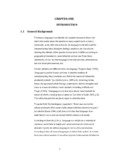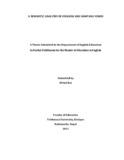Please use this identifier to cite or link to this item:
https://elibrary.tucl.edu.np/handle/123456789/939| Title: | A Semantic Analysis of English and Sampang Verbs |
| Authors: | Rai, Birbal |
| Keywords: | Semantic Analysis;Linguistic Situation;Contrastive Analysis;Componential Analysis |
| Issue Date: | 2011 |
| Publisher: | Department of Education English |
| Institute Name: | Central Department of Education |
| Level: | Masters |
| Abstract: | The thesis entitled ‘A Semantic Analysis of English and Sampang Verbs’ attempts to analyze some English and Sampang Verbs Correlation in terms of their meaning. The main purpose of this study is to analyze the English and Sampang verbs mainly on the basis of one to one correlation of meaning and convergence and divergence of meaning. To accomplish the objective of the study Sampang native speakers were taken as the main informants for eliciting the data. They were selected using judgemental sampling procedure and interviewed according to prepared interview schedule but English data were taken from secondary sources. The selected English and Sampang verbs have been described in contexts. Then, the meaning of those verbs have been analyzed following componential analysis approach. The main findings of the research study is that there are inherent differences in the semantic systems of English and Sampang verbs. This study shows that the Sampang language has more verbs of seeing, touching, cutting and breaking. It has also been found that the the suffix ‘-ma’ is added at end of the root of Sampang verbs referring to seeing, touching, cutting and breaking. This thesis has four chapters. They are introduction, methodology, analysis and interpretation and findings and recommandations. The first chapter consists of general background, literature review, objectives of the study, significance of the study and definition of the specific terms. Similarly, the second chapter includes sources of data, population of the study, sampling procedure, research tools, process of data collection and limitations of the study. Likewise, the third chapter includes analysis and interpretation of the thesis, which is its main part. Finally, the fourth chapter consists of findings, recommandations and pedagogical implications that are very crucial for long voyage of teaching. |
| URI: | http://elibrary.tucl.edu.np/handle/123456789/939 |
| Appears in Collections: | English Language Education |
Files in This Item:
| File | Description | Size | Format | |
|---|---|---|---|---|
| CHAPTER(1).pdf | 456.4 kB | Adobe PDF |  View/Open | |
| cover.pdf | 66.22 kB | Adobe PDF |  View/Open |
Items in DSpace are protected by copyright, with all rights reserved, unless otherwise indicated.
